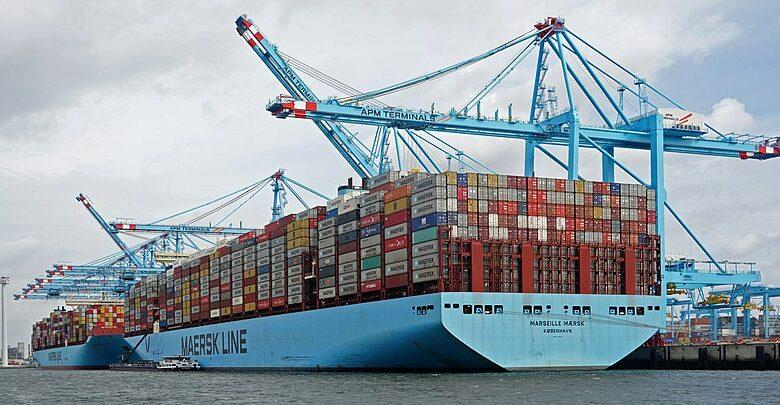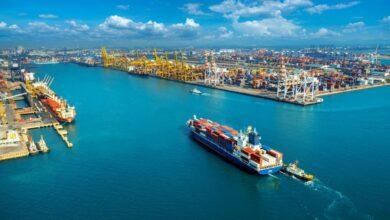
Top 20 Ports Handling the Largest Container Volumes
Top 20 Ports Handling the Largest Container Volumes – Shipping containers have revolutionized global trade and transportation since their introduction in the 1950s. Standardized containers allow goods to be transported efficiently between ships, trucks and trains without having to handle individual pieces of cargo. This has significantly reduced costs and transit times in the global supply chain.
Some of the world’s largest and busiest container ports handle millions of twenty-foot equivalent units (TEUs) each year. TEU is the standard unit used to measure a ship’s cargo carrying capacity, and is based on the volume of a standard 20-foot intermodal container. The massive scale of operations at these mega ports is a sight to behold, with acres of stacked colorful containers being loaded and offloaded 24/7 by armies of cranes and other heavy machinery.Top 20 Ports Handling the Largest Container Volumes
👉 Relocate to Canada Today!
Live, Study and Work in Canada. No Payment is Required! Hurry Now click here to Apply >> Immigrate to CanadaThis article profiles the top 20 container ports across the globe based on total TEUs handled annually. The list provides details on their features, locations and importance to global trade and transportation.
Top 20 Largest Container Ports
1. Shanghai, China
In 2021, the Port of Shanghai handled 47.2 million TEUs, the highest container throughput in the world. Strategically located at the mouth of the Yangtze River Delta, Shanghai is the world’s busiest container port. It is comprised of multiple terminals spread across coastal zones and islands. Shanghai’s deep natural harbor, size, infrastructure and connectivity make it a critical node in global supply chains.
Read Also: Top 15 USDT Marketplaces in Nigeria
2. Singapore
Singapore handled 37.2 million TEUs in 2021, cementing its status as the world’s 2nd busiest port. Its strategic location made Singapore a key transhipment hub between Europe and East Asia. Operated by PSA Singapore, its terminals feature advanced automation and excellent productivity. Due to land constraints, Singapore is expanding its container operations through the new Tuas Mega Port project.
3. Ningbo Zhoushan, China
As the world’s 3rd busiest container port, Ningbo Zhoushan handled 31.7 million TEUs in 2021. Located south of Shanghai, it serves the industrial zones of the Yangtze River Delta. Ningbo Zhoushan has emerged as an ultra-large automated container port capturing overflow cargo from Shanghai. Deepwater berths, large terminals and rail links add to its capacity.Good morning My Love Message
4. Shenzhen, China
The Port of Shenzhen, located close to Hong Kong, handled 27.7 million TEUs in 2021, making it the 4th largest container port globally. It serves as the main gateway for China’s industrial Pearl River Delta region. Operated by China Merchants Port Holdings, Shenzhen’s Yantian port is one of the world’s most technologically advanced and productive.
Read Also: Top 15 Leading Technology Institutions in Nigeria
5. Guangzhou Harbor, China
Guangzhou port comprises multiple terminals along Pearl River handling 27.4 million TEUs annually. A major transcriptional hub close to industrial Guangdong region, its strategic location boosted container volumes. Guangzhou is developing the massive Nansha Harbor Port to consolidate and expand its capabilities. Extensive rail and expressway links add to its connectivityInformation guide Nigeria
👉 Relocate to Canada Today!
Live, Study and Work in Canada. No Payment is Required! Hurry Now click here to Apply >> Immigrate to Canada6. Busan, South Korea
The Port of Busan, located in South Korea’s second-largest city, handled 23 million TEUs in 2021. Its natural harbor and proximity to major shipping routes in East Asia enabled it to become a leading transhipment hub. Operated by PSA and DP World, Busan is expanding infrastructure to grow volumes and connectivity. It provides critical links to Korea’s industrial hinterland.
7. Hong Kong, China
Despite dense urbanization, Hong Kong handled 19.6 million TEUs in 2021. Operated by Hutchison Port Holdings, its terminals provide connectivity between Mainland China and the world. Victoria Harbor provides deep berths close to the South China Sea shipping corridor. Hong Kong is reinforcing its role as a logistics hub through major infrastructure projects.
8. Qingdao, China
Home to China’s largest iron ore port, Qingdao also handled 19.3 million TEUs in 2021. Located on the Yellow Sea, it serves as gateway to China’s Shandong province. Operated partly by Hutchison Port Holdings, Qingdao’s capabilities are being upgraded through reclamation and enhanced rail links. Its cold storage abilities add to its growing hub status.Romantic love message
Read Also: Top 15 Nigerian Instagram Marketing Consultants in Nigeria
9. Tianjin, China
The Port of Tianjin handled 18.5 million TEUs in 2021. It serves northern China’s major industrial zones around Beijing. Located on Bohai Bay, Tianjin has built world-class container facilities to grow volumes. Operated by Tianjin Port Holdings among others, it is positioning itself as the primary hub for China’s Belt and Road initiative through Central Asia.
10. Port Klang, Malaysia
Malaysia’s main container port handled 17 million TEUs in 2021. Located in an estuary near the capital Kuala Lumpur, it is the busiest port in Southeast Asia. Operated by MMC Port Holdings, Port Klang offers excellent connectivity to Malaysia’s industrial zones and regional markets. Ongoing expansion of container terminals and associated infrastructure continues to boost its capacity.
11. Antwerp, Belgium
The Port of Antwerp, located along the Scheldt River, handled 16 million TEUs 2021. One of Europe’s largest ports, it offers seamless connectivity between Europe’s industrial heartland and the world. Operated by Port of Antwerp, its strategic location, rail and waterway links enable it to serve as northern Europe’s gateway. Ongoing expansion of its container handling capacity reflects its growthNYSC Portal
12. Xiamen, China
Located on China’s southeast coast facing Taiwan, Xiamen handled 15.7 million TEUs in 2021. Operated by Xiamen Port Holdings, it has capitalized on China’s burgeoning trade with ASEAN countries. With strong productivity and connectivity, Xiamen handles overflow cargo from the Pearl River Delta. Collaborations with inland ports is expanding its catchment area.
13. Rotterdam, Netherlands
Europe’s largest seaport, Rotterdam handled 15.3 million TEUs in 2021. Located at the mouth of the Rhine River, it serves as a key gateway between Europe and the world. Operated by Port of Rotterdam Authority, it offers seamless transshipment services along with water, road and rail connectivity to inland regions. Investment in automation and digitization aids productivity growth.
14. Dalian, China
The Port of Dalian handled 13.8 million TEUs in 2021. Strategically located on the Liaodong Peninsula near Beijing, it mainly serves Northeast China. Operated by Dalian Port Holdings, it has built dedicated container terminals offering direct calls to global shipping lines. It is positioning itself as a major hub port for North China through improving intermodal links.
Read Also: Top 15 Nigerian Actresses to Watch in 2023
15. Tanjung Pelepas, Malaysia
Tanjung Pelepas transformed from a village into a world-class container port handling 13.6 million TEUs annually. Located strategically on the Malacca Strait, it serves as gateway between Southeast Asia and Europe/Middle East. Operated by MMC Port Holdings, its high productivity and deep berths attract calls from the world’s largest container vessels.JAMB portal
16. Kaohsiung, Taiwan
The Port of Kaohsiung handled 12 million TEUs in 2021. Located on Taiwan’s southwestern coast, it is the largest harbor in Taiwan. Operated by Taiwan International Ports Corporation, it serves as the island’s main container gateway with direct links to global trade routes. Ongoing expansion of its terminals, berths and associated infrastructure continues to boost volumes.
17. Hamburg, Germany
The Port of Hamburg handled 11.8 million TEUs in 2021. Situated on the Elbe River 100 km inland from North Sea, it is Germany’s largest seaport. Operated by Hamburg Port Authority, it offers seamless connectivity between worldwide maritime trade and Central Europe via rail, road and inland waterways. Upgrading of container terminals is increasing Hamburg’s capacity.
18. Los Angeles, USA
The Port of Los Angeles handled 10.7 million TEUs in 2021, making it the busiest container port in the Americas. Operated by Port of Los Angeles, it serves as the primary gateway for US-Asian trade. Its location close to major intermodal infrastructure enables excellent connectivity with North America’s industrial and consumer hinterlands. Expansion works are underway to handle growing volumes.
19. Long Beach, USA
Adjacent to Los Angeles, the Port of Long Beach handled 9.4 million TEUs in 2021. Operated by Harbor Department of the City of Long Beach, it serves a vital role in US-Asia trade. Investment in digitalization aids operational efficiency. With land availability, Long Beach is boosting capacity through infrastructure projects to capture burgeoning demand.
20. New York / New Jersey, USA
The Port of New York & New Jersey handled 8.7 million TEUs in 2021. Linking North America’s dense consumer markets with global trade, it is the busiest port on the US East Coast. Operated jointly across New York and New Jersey, it offers rail connectivity and congestion mitigation efforts continue to aid efficiency. Expansion works are underway to grow its capabilities.
Read Also: Top 15 AirPods Models in Nigeria
Conclusion
The phenomenal scale achieved by the world’s mega container ports highlights the critical role they play in enabling global trade. Strategic locations, infrastructure, connectivity, productivity and scale determine the competitiveness of leading container hubs. Asian ports, especially Chinese, dominate the rankings, underlining the region’s manufacturing export power. Global container volumes are projected to grow driven by international commerce, necessitating major capacity enhancement efforts across top ports. Efficiency, automation and digitization aid them in handling ever larger shares of global containerized trade.
Check JAMB RESULT
Check and Confirm: How much is Dollar to Naira








